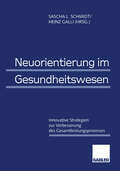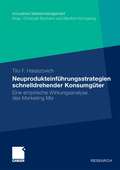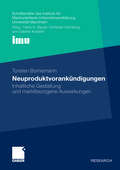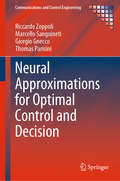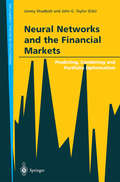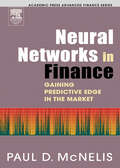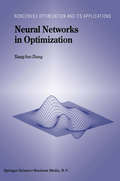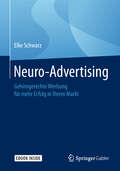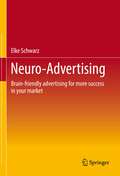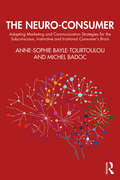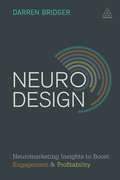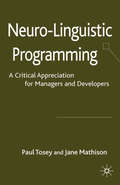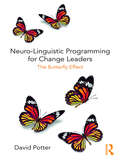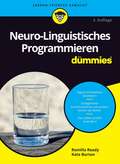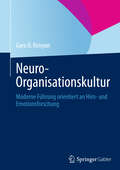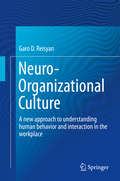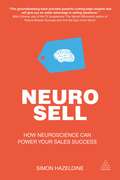- Table View
- List View
Neuorientierung des Widerstands in Hongkong: Linkssein, Dekolonialität und Internationalismus
by Wen Liu Jn Chien Christina Chung Ellie TseDieses Buch versammelt Beiträge von Aktivisten und Wissenschaftlern, die sich mit linken und dekolonialen Formen des Widerstands befassen, die in der aktuellen Ära der Proteste in Hongkong entstanden sind. Praktiken wie gewerkschaftliches Engagement, die Abschaffung der Polizei, der Kampf um Landrechte und andere radikale Ausdrucksformen der Selbstverwaltung werden vielleicht nicht explizit unter den Bannern der Linken und der Dekolonialität geführt. Wenn man sie jedoch in diesem Rahmen untersucht, lassen sich historische, transnationale und präfigurative Perspektiven aufzeigen, die helfen können, ihre Auswirkungen auf die politische Zukunft Hongkongs zu kontextualisieren und zu interpretieren. Diese Sammlung bietet nicht nur Einblicke in die lokalen Kämpfe in Hongkong, sondern auch in ihre Verflechtung mit globalen Bewegungen, da die Stadt weiterhin an der vordersten Front der internationalen Politik steht.
Neuorientierung des Wissensmanagements: Paradoxien und Dysfunktionalitäten im Umgang mit der Ressource Wissen (Wirtschaftswissenschaften)
by Jürgen Howaldt Rüdiger Klatt Ralf KoppDie Autoren dokumentieren die zentralen Ergebnisse des vom Bundesministerium für Bildung und Forschung (BMBF) geförderten Forschungsprojektes cross company knowledge management (crosscomp). Ziel war die Erforschung und Erprobung neuer Konzepte und Methoden der Wissensgenerierung in organisationsübergreifenden Kooperationsnetzwerken entlang der Wertschöpfungskette Wissen. Im Mittelpunkt stehen kleine und mittelgroße Dienstleistungsunternehmen im Bereich Organisationsberatung und Multimedia/IT.
Neuorientierung für Führungskräfte: Berater in eigener Sache
by Michael Lorenz Uta Rohrschneider Dieses Buch ist speziell auf die Situation von Führungskräften zugeschnitten, die aus unterschiedlichen Gründen eine berufliche Neuorientierung anstreben. Es vermittelt dem Leser treffsicher, was er über seine eigene Neuplatzierung wissen sollte. Wie erkennt man, dass sich eine Trennungssituation anbahnt? Welche Chancen bietet die berufliche Umbruchsituation? Wie lässt sich der Karrierewechsel persönlich, finanziell und auch mit der Familie erfolgreich meistern? Wertvolle Praxistipps, Checklisten zur Selbstanalyse und hilfreiche Adressen zur Auswahl von Coaches, Headhuntern und Outplacementberatern liefern weiteres Rüstzeug für den erfolgreichen Neustart.
Neuorientierung im Gesundheitswesen: Innovative Strategien zur Verbesserung des Gesamtleistungsprozesses
by Sascha L. Schmidt Heinz GalliInternational bekannte Experten aus den USA, Deutschland, Frankreich und der Schweiz zeigen Möglichkeiten zur Entwicklung und Umsetzung notwendiger langfristiger Strategien im Gesundheitswesen auf.
Neuprodukteinführungsstrategien schnelldrehender Konsumgüter: Eine empirische Wirkungsanalyse des Marketing Mix (Innovatives Markenmanagement)
by Tilo F. HalaszovichTilo F. Halaszovich quantifiziert mit Hilfe dynamischer Paneldatenmodelle aus verschiedenen europäischen Ländern den Einfluss des Marketing Mix auf unterschiedliche Größen des Markterfolgs.
Neuproduktvorankündigungen: Inhaltliche Gestaltung und marktbezogene Auswirkungen (Schriftenreihe des Instituts für Marktorientierte Unternehmensführung (IMU), Universität Mannheim)
by Torsten BornemannNeural Approximations for Optimal Control and Decision (Communications and Control Engineering)
by Riccardo Zoppoli Marcello Sanguineti Giorgio Gnecco Thomas ParisiniNeural Approximations for Optimal Control and Decision provides a comprehensive methodology for the approximate solution of functional optimization problems using neural networks and other nonlinear approximators where the use of traditional optimal control tools is prohibited by complicating factors like non-Gaussian noise, strong nonlinearities, large dimension of state and control vectors, etc. Features of the text include: • a general functional optimization framework; • thorough illustration of recent theoretical insights into the approximate solutions of complex functional optimization problems; • comparison of classical and neural-network based methods of approximate solution; • bounds to the errors of approximate solutions; • solution algorithms for optimal control and decision in deterministic or stochastic environments with perfect or imperfect state measurements over a finite or infinite time horizon and with one decision maker or several; • applications of current interest: routing in communications networks, traffic control, water resource management, etc.; and • numerous, numerically detailed examples. The authors’ diverse backgrounds in systems and control theory, approximation theory, machine learning, and operations research lend the book a range of expertise and subject matter appealing to academics and graduate students in any of those disciplines together with computer science and other areas of engineering.
Neural Networks and the Financial Markets: Predicting, Combining and Portfolio Optimisation (Perspectives in Neural Computing)
by Jimmy ShadboltNeural Networks in Finance: Gaining Predictive Edge in the Market (Academic Press Advanced Finance)
by Paul D. McNelisThis book explores the intuitive appeal of neural networks and the genetic algorithm in finance. It demonstrates how neural networks used in combination with evolutionary computation outperform classical econometric methods for accuracy in forecasting, classification and dimensionality reduction. McNelis utilizes a variety of examples, from forecasting automobile production and corporate bond spread, to inflation and deflation processes in Hong Kong and Japan, to credit card default in Germany to bank failures in Texas, to cap-floor volatilities in New York and Hong Kong.* Offers a balanced, critical review of the neural network methods and genetic algorithms used in finance * Includes numerous examples and applications * Numerical illustrations use MATLAB code and the book is accompanied by a website
Neural Networks in Optimization (Nonconvex Optimization and Its Applications #46)
by Xiang-Sun ZhangPeople are facing more and more NP-complete or NP-hard problems of a combinatorial nature and of a continuous nature in economic, military and management practice. There are two ways in which one can enhance the efficiency of searching for the solutions of these problems. The first is to improve the speed and memory capacity of hardware. We all have witnessed the computer industry's amazing achievements with hardware and software developments over the last twenty years. On one hand many computers, bought only a few years ago, are being sent to elementary schools for children to learn the ABC's of computing. On the other hand, with economic, scientific and military developments, it seems that the increase of intricacy and the size of newly arising problems have no end. We all realize then that the second way, to design good algorithms, will definitely compensate for the hardware limitations in the case of complicated problems. It is the collective and parallel computation property of artificial neural net works that has activated the enthusiasm of researchers in the field of computer science and applied mathematics. It is hard to say that artificial neural networks are solvers of the above-mentioned dilemma, but at least they throw some new light on the difficulties we face. We not only anticipate that there will be neural computers with intelligence but we also believe that the research results of artificial neural networks might lead to new algorithms on von Neumann's computers.
Neurere Entwicklungen in der Angewandten Ökonometrie (Wirtschaftswissenschaftliche Beiträge #23)
by Gholamreza Nakhaeizadeh Karl-Heinz VollmerNeuro-Advertising: Gehirngerechte Werbung für mehr Erfolg in Ihrem Markt
by Elke SchwarzFinden Sie mit diesem Buch zum Thema Neuro-Advertising heraus, wie Sie Ihren Marketingerfolg steigern könnenDas Marketing ist eine der wichtigsten Abteilungen in einem Unternehmen. Es ist dafür zuständig, neue Kunden zu werben und Bestandskunden zu halten. Leider werden in vielen Fällen hohe Budgets für Marketingstrategien aufgewendet, die nur einen geringen Effekt erzielen. Dieses Buch über das Neuro-Advertising hilft Ihnen dabei, die Wirkung Ihres Advertisings effektiv zu steigern. Es basiert auf dem „Subconscious Decision Marketing Index“ (SDMI). Diese neurowissenschaftliche Methode stellt ein neues Marketinginstrument dar, mit dessen Hilfe sich die unbewusste Wirkung von Werbung messen lässt. Dazu gehören:GesichtszügeKörperreaktionenEmotionenGehirnaktivitätenSo können Werbestrategien effektiv geplant und die Marketing-Effizienz nachhaltig gesteigert werden. Es wird gemessen, wie erfolgreich Werbung wirkt oder eben nicht. Dann können Werbemaßnahmen entsprechend der Zielgruppe gestaltet werden. Marketing-Agenturen können von dieser Technik ebenso profitieren wie die Marketer, die für Unternehmen tätig sind.Kennzahlen helfen dabei, Ergebnisse zu vergleichenÜblicherweise ist es schwer, unbewusste Emotionen und Regungen zu messen. Diese neue Methode schafft jedoch genau das, indem sie Kennzahlen im Rahmen der Verbraucherforschung erstellt. So können einzelne Indices der Marketing-Effektivität gemessen werden:Emotional Index: Welche Emotionen löst die Werbung aus?Benefit-Index: Inwieweit überzeugt die Werbung durch gehirngerechte Nutzen?Memory-Index: Wie hoch ist der tatsächliche Erinnerungswert?Hormon-Index: Welche hormonellen Reaktionen werden ausgelöst und wie beeinflussen sie den Kaufprozess bei Kunden?Impuls-Index: Wie gut nutzt die Werbung die Impulsmöglichkeiten?Diese Indices können Sie wiederum leicht mit vorherigen Messungen vergleichen und klare Handlungsempfehlungen daraus ableiten.Das Buch über das Neuro-Advertising erklärt diese Methode praxisnah, wodurch Sie sie direkt in Ihre Marketingplanung integrieren können.
Neuro-Advertising: Brain-friendly advertising for more success in your market
by Elke SchwarzFind out how to increase your marketing success with this book on neuro-advertising. Marketing is one of the most important departments in a company. It is responsible for attracting new customers and retaining existing customers. Unfortunately, in many cases, high budgets are spent on marketing strategies that have little effect. This book on neuro-advertising will help you to effectively increase the impact of your advertising. It is based on the "Subconscious Decision Marketing Index" (SDMI). This neuroscientific method represents a new marketing tool that can be used to measure the subconscious impact of advertising. These include: Facial features Body Reactions Emotions Brain activity In this way, advertising strategies can be effectively planned and marketing efficiency sustainably increased. It is measured how successful advertising is or is not. Then advertising measures can be designed according to the target group. Marketing agencies can benefit from this technique as well as marketers working for companies. Key figures help to compare results Typically, it is difficult to measure unconscious emotions and emotions. However, this new method manages to do just that by creating metrics in the context of consumer research. In this way, individual indices of marketing effectiveness can be measured: Emotional Index: What emotions does advertising trigger? Benefit Index: To what extent does the advertising convince with brain-appropriate benefits? Memory index: How high is the actual memory value? Hormone index: Which hormonal reactions are triggered and how do they influence the buying process of customers? Impulse Index: How well does advertising use impulse opportunities? In turn, you can easily compare these indices with previous measurements and derive clear recommendations for action. The book on neuro-advertising explains this method in a practical way, allowing you to integrate it directly into your marketing planning.
The Neuro-Consumer: Adapting Marketing and Communication Strategies for the Subconscious, Instinctive and Irrational Consumer's Brain
by Anne-Sophie Bayle-Tourtoulou Michel BadocNeuroscientific research shows that the great majority of purchase decisions are irrational and driven by subconscious mechanisms in our brains. This is hugely disruptive to the rational, logical arguments of traditional communication and marketing practices and we are just starting to understand how organizations must adapt their strategies. This book explains the subconscious behavior of the "neuro-consumer" and shows how major international companies are using these findings to cast light on their own consumers’ behavior. Written in plain English for business and management readers with no scientific background, it focuses on: how to adapt marketing and communication to the subconscious and irrational behaviors of consumers; the direct influence of the primary senses (sight, hearing, smell, taste, touch) on purchasing decisions and the perception of communications by customers’ brains; implications for innovation, packaging, price, retail environments and advertising; the use of "nudges" and artifices to increase marketing and communication efficiency by making them neuro-compatible with the brain’s subconscious expectations; the influence of social media and communities on consumers’ decisions – when collective conscience is gradually replacing individual conscience and recommendation becomes more important than communication; and the ethical limits and considerations that organizations must heed when following these principles. Authored by two globally recognized leaders in business and neuroscience, this book is an essential companion to marketers and brand strategists interested in neuroscience and vital reading for any advanced student or researcher in this area.
The Neuro-Consumer: Adapting Marketing and Communication Strategies for the Subconscious, Instinctive and Irrational Consumer's Brain
by Anne-Sophie Bayle-Tourtoulou Michel BadocNeuroscientific research shows that the great majority of purchase decisions are irrational and driven by subconscious mechanisms in our brains. This is hugely disruptive to the rational, logical arguments of traditional communication and marketing practices and we are just starting to understand how organizations must adapt their strategies. This book explains the subconscious behavior of the "neuro-consumer" and shows how major international companies are using these findings to cast light on their own consumers’ behavior. Written in plain English for business and management readers with no scientific background, it focuses on: how to adapt marketing and communication to the subconscious and irrational behaviors of consumers; the direct influence of the primary senses (sight, hearing, smell, taste, touch) on purchasing decisions and the perception of communications by customers’ brains; implications for innovation, packaging, price, retail environments and advertising; the use of "nudges" and artifices to increase marketing and communication efficiency by making them neuro-compatible with the brain’s subconscious expectations; the influence of social media and communities on consumers’ decisions – when collective conscience is gradually replacing individual conscience and recommendation becomes more important than communication; and the ethical limits and considerations that organizations must heed when following these principles. Authored by two globally recognized leaders in business and neuroscience, this book is an essential companion to marketers and brand strategists interested in neuroscience and vital reading for any advanced student or researcher in this area.
Neuro Design: Neuromarketing Insights to Boost Engagement and Profitability
by Darren BridgerCommended: 2018 Business Book Awards - Thought Leader categoryToday, businesses of all sizes generate a great deal of creative graphic media and content, including websites, presentations, videos and social media posts. Most big companies, including the likes of Procter & Gamble, Coca-Cola, Tesco and Google, now use neuroscience research and theories to optimize their digital content. Neuro Design opens up this new world of neuromarketing design theories and recommendations, and describes insights from the growing field of neuroaesthetics that will enable readers to enhance customer engagement through their website, and boost profitability. Neuro Design emphasizes the importance of understanding consumers' non-conscious reactions to design and how brands can use them to improve performance, and increase the credibility and persuasiveness of their content. Including practical methods such as neuro-research for testing websites, plus real world case studies from P&G, Coca-Cola, Google and neuroscientific advertising for Nielson, this is the essential handbook for any marketer looking to improve engagement with their creative graphic content. Also covering visuospatial resonance, banner blindness, visual saliency, the Gestalt Psychology Model, the halo effect and much more, Neuro Design will equip any marketer with the design techniques they need to engage with consumers. Online resources include web links to inspiring reading, and further website resources.
Neuro Design: Neuromarketing Insights to Boost Engagement and Profitability
by Darren BridgerCommended: 2018 Business Book Awards - Thought Leader categoryToday, businesses of all sizes generate a great deal of creative graphic media and content, including websites, presentations, videos and social media posts. Most big companies, including the likes of Procter & Gamble, Coca-Cola, Tesco and Google, now use neuroscience research and theories to optimize their digital content. Neuro Design opens up this new world of neuromarketing design theories and recommendations, and describes insights from the growing field of neuroaesthetics that will enable readers to enhance customer engagement through their website, and boost profitability. Neuro Design emphasizes the importance of understanding consumers' non-conscious reactions to design and how brands can use them to improve performance, and increase the credibility and persuasiveness of their content. Including practical methods such as neuro-research for testing websites, plus real world case studies from P&G, Coca-Cola, Google and neuroscientific advertising for Nielson, this is the essential handbook for any marketer looking to improve engagement with their creative graphic content. Also covering visuospatial resonance, banner blindness, visual saliency, the Gestalt Psychology Model, the halo effect and much more, Neuro Design will equip any marketer with the design techniques they need to engage with consumers. Online resources include web links to inspiring reading, and further website resources.
Neuro-Linguistic Programming: A Critical Appreciation for Managers and Developers
by P. Tosey J. MathisonAddressing the need for a discerning, research-based discussion of NLP, this book seeks to answer the many questions that clients, potential users and practitioners ask, including: what is NLP and what can it best be used for? This book looks at the research and theory behind NLP, also exploring claims that it is a `pseudoscience'.
Neuro-Linguistic Programming for Change Leaders: The Butterfly Effect
by David PotterWe know a lot about change leadership. We understand how to design change programmes, and we know how to prescribe best practice change methods. Yet, despite all this knowledge, it is reported that up to 70% of change leadership projects fail to realize many of their objectives. The fault lines are cited as occurring at the micro level of social interaction. What we don’t adequately explain and demonstrate within the change leadership literature is how change leaders may consciously generate in themselves and in others resourceful mindsets, emotions, attitudes, and behaviours to enable positive change leadership dynamics. Neuro-Linguistic Programming for Change Leaders: The Butterfly Effect fills this gap by connecting the practices of personal development with those of corporate change leadership. This book has the vision of advancing NLP as a serious technology in the change leader’s tool box. The book introduces to operations managers, HR practitioners, OD specialists, and students of management new ideas and practices, which can transform their effectiveness as change leaders. It focuses on the benefits of applied NLP to change leaders as a generative change toolkit. Secondly, the book provides a model that shows change leaders how to build a climate of psychological safety to establish rapport with stakeholders. Thirdly, the book provides a strategy for enabling broader cultural change and stakeholder engagement throughout the organization.
Neuro-Linguistic Programming for Change Leaders: The Butterfly Effect
by David PotterWe know a lot about change leadership. We understand how to design change programmes, and we know how to prescribe best practice change methods. Yet, despite all this knowledge, it is reported that up to 70% of change leadership projects fail to realize many of their objectives. The fault lines are cited as occurring at the micro level of social interaction. What we don’t adequately explain and demonstrate within the change leadership literature is how change leaders may consciously generate in themselves and in others resourceful mindsets, emotions, attitudes, and behaviours to enable positive change leadership dynamics. Neuro-Linguistic Programming for Change Leaders: The Butterfly Effect fills this gap by connecting the practices of personal development with those of corporate change leadership. This book has the vision of advancing NLP as a serious technology in the change leader’s tool box. The book introduces to operations managers, HR practitioners, OD specialists, and students of management new ideas and practices, which can transform their effectiveness as change leaders. It focuses on the benefits of applied NLP to change leaders as a generative change toolkit. Secondly, the book provides a model that shows change leaders how to build a climate of psychological safety to establish rapport with stakeholders. Thirdly, the book provides a strategy for enabling broader cultural change and stakeholder engagement throughout the organization.
Neuro-Linguistisches Programmieren für Dummies (Für Dummies)
by Romilla Ready Kate BurtonMöchten Sie andere Menschen besser verstehen und sich ihnen gegenüber besser verständlich machen? Dann ist dieses Buch genau das richtige für Sie. Romilla Ready und Kate Burton zeigen Ihnen, wie Sie mit NLP Ihre Kommunikation mit anderen erfogreich gestalten können und Ihre Ziele leichter erreichen. Sie erfahren, was es mit "Landkarten", "Ankern", "Zeitreisen" oder "Rapport" auf sich hat und werden schon bald merken wie Sie einen neuen Blick auf Ihre Umwelt werfen und wie positiv sich Ihre Kommunikation mit anderen entwickelt.
Neuro-Organisationskultur: Moderne Führung orientiert an Hirn- und Emotionsforschung
by Garo D. Reisyan„Neuro-Organisationskultur“ oder kurz „Neurokultur“ baut auf die Erfahrungen auf, die in den letzten 30 Jahren mit Organisationskultur gemacht wurden und ergänzt sie um neueste Erkenntnisse aus Hirn- und Emotionsforschung sowie um wichtige Einsichten aus Soziologie und Psychologie.Die aktuelle Konzeptlandschaft zum Thema Organisationskultur ist im Kern 20-30 Jahre alt und weist für praktische Operationalisierungen gravierende Unzulänglichkeiten auf. Mit dem Konzept „Neurokultur“ wird ein neuartiges Kulturmodell vorgestellt, das im Kern die drei Bausteine Reflexivität, Vorstellungen und Emotionen aufweist. Dazu führt der Autor in die neurowissenschaftlichen Grundlagen z. B. von Wahrnehmung, Gedächtnis und Lernen ein und macht mit Konstrukten, wie etwa Emotion, Stress, kognitiver Dissonanz, Intelligenz, Aufmerksamkeit und Kreativität vertraut. Neuartig ist auch, dass Gruppen und Individuen konsistent unter einem Dach konzeptualisiert wurden. Insgesamt ergibt sich ein signifikant belastbareres Verständnis von kulturellen Phänomenen und menschlichem Verhalten, wodurch sich neue Möglichkeiten der Operationalisierung eröffnen. Dazu wird ein struktureller Rahmen nebst Begriffsinventar sowie konkrete Methoden und Vorlagen zur Analyse, kontinuierlichen Pflege und gezielten Veränderung von Organisationskultur dargeboten.Schließlich werden wichtige Megatrends skizziert, auf deren Basis Anforderungen an das kulturelle Profil von Organisationen des 21. Jahrhunderts abgeleitet werden. Das praxisorientierte Buch enthält zahlreiche Beispiele aus Unternehmen und Exkurse zu aktuellen Themen aus Gesellschaft, Politik und allgemeiner Lebensführung.
Neuro-Organizational Culture: A new approach to understanding human behavior and interaction in the workplace
by Garo D. ReisyanThis book introduces a new concept on organizational culture, called ‘Neuro-Organizational Culture’, or ‘Neuroculture’; a concept that is based on the most recent neuroscientific knowledge. The book describes a new approach to understanding human behavior and interaction in the workplace, replacing the old concept of organizational culture by one that takes into account humans’ perceiving, feeling, thinking, and acting. Taking advantage of the substantial progress that has been made in neuroscientific research, the book combines experiences gained from organizational culture in the past 30 years with the latest findings from brain and emotion research, as well as with important insights from sociology and psychology. The book explains the three building blocks of Neuroculture: Reflexivity, Notions, and Emotions. Neuroculture consistently conceptualizes the culture of groups and individuals consistently under one roof, which allows for a better explanation of individual deviations. It provides a structural framework and an inventory along with proven methods and templates to analyze, continuously foster and actively change organizational culture. In addition, it outlines global megatrends in order to define cultural requisites that promote sustainable success of organizations in the 21st century.
Neuro-Sell: How Neuroscience can Power Your Sales Success
by Simon HazeldineAnyone involved in sales faces huge challenges these days, from fierce global competition and increased pressure on margins to the power of internet-savvy buyers and difficulties with getting time with prospective buyers. To succeed in sales, something more than the traditional techniques is needed. Neuro-Sell presents an effective, brain-based approach to selling that is sensitive to what's going on in the customer's mind.Neuro-Sell helps readers understand the importance of the unconscious and get below the surface of what people say to recognise what they really mean. Packed with examples, quizzes, templates and interactive exercises, it develops readers' skills in building sales relationships with the four main types of buyer and outlines the five stages of neuro-negotiating that will help give readers the competitive edge.
Neuro-Sell: How Neuroscience can Power Your Sales Success
by Simon HazeldineAnyone involved in sales faces huge challenges these days, from fierce global competition and increased pressure on margins to the power of internet-savvy buyers and difficulties with getting time with prospective buyers. To succeed in sales, something more than the traditional techniques is needed. Neuro-Sell presents an effective, brain-based approach to selling that is sensitive to what's going on in the customer's mind.Neuro-Sell helps readers understand the importance of the unconscious and get below the surface of what people say to recognise what they really mean. Packed with examples, quizzes, templates and interactive exercises, it develops readers' skills in building sales relationships with the four main types of buyer and outlines the five stages of neuro-negotiating that will help give readers the competitive edge.



